Chinese Name: 山西博物院 Pronunciation: Shānxī Bówùyuàn
Building Time: 1919
Best Visiting Season: All seasons
Recommended Time for Visit: 2-3 Hours
Occupied Area: About 112,000 square meters
Address: No.13, North Section of Binhe West Road, Taiyuan City, Shanxi, China
Building Function: Undertaking the responsibility and mission of inheriting Chinese civilization and Shanxi’ history and culture
1. Visitors should make real-name reservations three days in advance (including the day of booking) by clicking on “Visit Service” on the WeChat official account platform (WeChat ID: Shanxi Museum).
2. Each booking can only make a reservation for three people, and each ID card can be used once per day. Please keep the reservation voucher well.
3. Chinese and English interpretation service is provided at the front desk of the main hall on the first floor. The content of the interpretation is the basic display of seven historical topics.
4. The interpretation time is about 1 hour. If the time is exceeded, an additional fee of 50 yuan per hour will be charged.
| Number of Visitors | Price of Interpretation Service |
| 1-10 | 100 yuan |
| 11-15 | 150 yuan |
| 16-20 | 200 yuan |
| 21-25 | 250 yuan |
| 26-30 | 300 yuan |
1. After 16:00, admission is not allowed.
2. Shanxi Museum is closed on Chinese New Year’s Eve and the Chinese New Year.
3. Shanxi Museum is closed on Mondays except that the Monday meets the national holiday.

Shanxi Museum is located at No.13, North Section of Binhe West Road, west bank of Binhe River, Taiyuan City, Shanxi Province. It was formerly known as Shanxi Education Library Museum, which was founded in 1919 and has been renamed several times since then. Since 1953, it has been called Shanxi Provincial Museum.
Shanxi Museum is the largest public cultural service institution for the collection, protection, research, and display of cultural relics in Shanxi Province, which undertakes the responsibility and the mission of inheriting Chinese civilization and Shanxi history and culture. Since March 2008, it has been open to the public for free. It was selected as one of the first National First-Class Museums. In 2009, it became one of the 11 national-level museums jointly built by the central and local governments.
The construction of the new museum started in 2001 and was completed in 2004. It was named Shanxi Museum. It is a modern comprehensive museum, a key construction project of the Ninth Five-Year Plan, and is also the cultural infrastructure with the largest investment scale in Shanxi Province since the establishment of the People’s Republic of China.
The new museum covers an area of about 112,000 square meters, with a building area of 52,000 square meters, an exhibition area of 13,000 square meters, and a total investment of nearly 400 million yuan. It enjoys a history of more than 100 years and has a rare collection of about 400,000 pieces (as of September 2015).
Among them, there are 40,282 pieces (groups) of precious relics, including 2,129 first-level relics, and about 110,000 ancient books. The collections are typified by bronze, porcelain, stone carving, Buddhist statues, murals, and works of calligraphy and paintings.

The basic display of Shanxi Museum takes “Jin Soul” as its theme (Shanxi Province is also known as Jin). It is composed of seven historical and cultural topics, namely, “The Cradle of Civilization”, “The Trace of the Xia and Shang Dynasties”, “The Achievements of Jin Kingdom”, “The Melting Pot of Different Nationalities”, “The Relics of Buddhism”, “The Hometown of Operas”, and “Shanxi Merchants”, as well as five artistic topics, “Ancient Architecture”, “Jade”, “Ancient Chinese Painting and Calligraphy ”, “Ancient Chinese Currency”, and “Ancient Chinese Porcelain”.
The Cradle of Civilization. It is composed of “The Life of the Remote Antiquity” and “The Taproot of Chinese Civilization”, showing the ancient human and civilization of Shanxi. In the Neolithic age, the splendid culture created by Chinese ancestors spread all over Shanxi. At the foot of Ta’er mountain, archeologists discovered the ruins of cities, characters, bronzes, ritual vessels, observatories, and many others, all of which symbolize that Chinese ancestors have stepped into the gate of civilization. The earliest “Chinese” started from here and headed for the future.
The Trace of the Xia and Shang Dynasties. It is composed of “The Ruins of Xia Period”, “The Important Places of the Shang Dynasty, and “The Treasures of the Local States”, which clearly show that southern Shanxi is one of the central areas of the Xia culture.
The Achievements of Jin Kingdom. Southern Shanxi is the first fiefdom and central area of the Jin State (1033 BC-376 BC), with rich remains. Qu Village is the early capital of the Jin State. “Ancient City of Jinyang” in the central region was the political and military base of Zhao Jianzi, who was in charge of the government at the end of the Jin State, and later the city became the initial capital of the Zhao State.
The Melting Pot of Different Nationalities. Since the Han Dynasty (202 BC to 220 AD), the northern ethnic groups have constantly collided with people in the central plains, along with cultural exchanges and ethnic integration. In the Southern and Northern Dynasties (420-589), the central plains were disturbed, and the ethnic groups in Mobei (the north of the Gobi) rose one after another, ruling Shanxi and galloping in the central plains. More than 300 years of war and suffering also contributed to the unprecedented scale of national integration in Chinese history.
The Relics of Buddhism. It shows ancient Buddhist sculptures in Shanxi, including not only Yungang Grottoes and Tianlongshan Grottoes, but also various Buddhist statues in ancient temples in the countryside.
The Hometown of Operas. It shows that Shanxi is one of the birthplaces of Chinese opera and enjoys the reputation of “Hometown of Chinese Opera Art”.
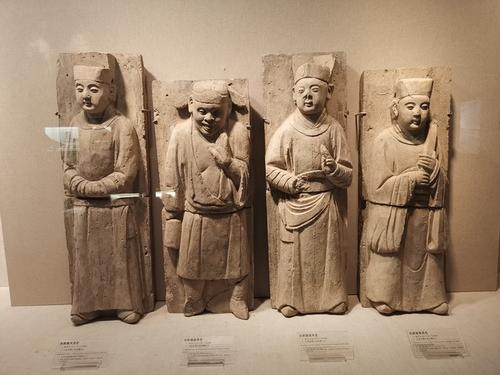
Shanxi Merchants. In the early years of the Ming Dynasty (1368-1644), Shanxi merchants began to manage grain and salt with the opportunity of huge military demand in the northern frontier of the Ming Dynasty.
Ancient Chinese Painting and Calligraphy. Shanxi Museum houses thousands of paintings and works of calligraphy from the past dynasties, from which some works of the Yuan (1271-1368), the Ming, and the Qing (1644-1912) Dynasties are exhibited.
Ancient Chinese Porcelain. Among the porcelain collections from the Northern Dynasty to the Ming and Qing Dynasties in Shanxi Museum, the northern porcelain is the most distinctive. There are celadon of the Northern Dynasty (386-581), celadon of the Sui and Tang Dynasties (581-907), and porcelain of famous kilns of the Song Dynasty (960-1279).
Ancient Chinese Currency. Ancient Chinese currency, mainly metal coins, was produced as early as the Xia and Shang Dynasties (about 2070 BC-1046 BC) and had developed throughout the following dynasties. Ancient Chinese coins in Shanxi Museum, to a certain extent, reproduce the historical track of the emergence and development of ancient Chinese currency and are the symbols of economic activities and technological development.
Ancient Architecture. Ancient Chinese architecture is a unique architectural system, which takes civil structure as the main body and skillfully integrates Chinese philosophy and the aesthetic taste. Shanxi is known as the “treasure house of ancient Chinese architecture”, and there are more than 18,000 ancient buildings in Shanxi Province.
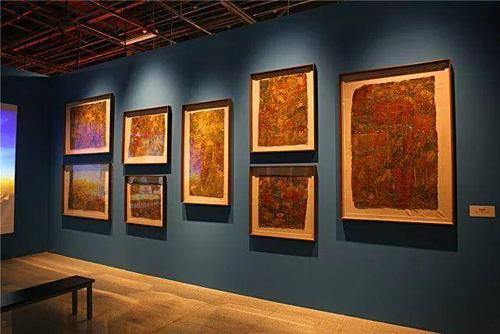
Shanxi Museum regularly holds a series of colorful and significant temporary exhibitions and special exhibitions that reflect Shanxi’s history, culture, and cultural relics, such as the exhibitions of “The Essence of Jin Relics”, “Shanxi Buddhist Sculpture Art”, “Painting and Calligraphy of Fu Shan”, and “Shanxi Modern Opera Brick Carving Art” at home and abroad.
In addition, Shanxi Museum carries out a variety of educational activities, such as mobile exhibitions, historical lectures, and interactive participation, covering various public cultural places and institutions, to showcase the beauty and profoundness of Shanxi’s history and culture from a multi-cultural perspective.
As the inheritor, pioneer, and guide of the culture of the Sanjin culture (Shanxi is also known as Sanjin), Shanxi Museum has been successively awarded the following honors: the Top Ten Exhibitions of National Museums, the Advanced Units for National Cultural Heritage Protection, the Advanced Units for the National Cultural System Reform, the National Most Innovative Museum, the National May 1 Labour Medal, the National Youth Civilization, etc. and it has won the title of Shanxi Province Civilization Unit several times.
On October 9, 1919, the predecessor of Shanxi Museum, Shanxi Education Library Museum was established.
In October 1925, Shanxi Education Library Museum was renamed Shanxi Public Library. The area was expanded to 90,000 square meters. The museum became an affiliated institution to the library.
In 1933, the Museum was renamed Shanxi Provincial People’s Education Museum and in 1937 was named Taiyuan Library.
After the victory of the War of Resistance Against Japanese Aggression, the name of Shanxi Provincial People’s Education Museum was restored.
In April 1949, Shanxi Provincial People’s Education Museum was taken over by the Cultural and Educational Takeover Group of the PLA Taiyuan Military Commission, and then was renamed Shanxi Provincial Library Museum, with the Museum Department under it.
In September 1953, Shanxi Provincial Library Museum merged with Taiyuan Cultural Relics Museum, renamed Shanxi Provincial Museum.
In 1956, Shanxi Provincial Museum, with the purpose of “serving scientific research and serving the general public”, successively completed the basic displays and was opened to the public.
In 1997, the new project of Shanxi Museum was approved.
In 2001, the foundation of the new Shanxi Museum was laid.
In 2004, the construction of the new museum was completed, and the museum was named Shanxi Museum. In August, the exhibition design project was launched.
On January 8, 2005, the exhibition of “Jin Soul” was previewed at the newly completed museum, soliciting opinions from people from all walks of life. On September 26, the basic display “Jin Soul” was officially opened to the public.
On July 27, 2019, Shanxi Bronze Museum, an important public cultural project of Shanxi Province and a sub-museum of Shanxi Museum, was opened to the public.
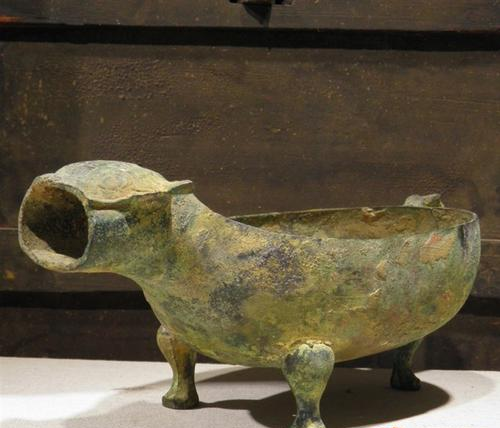
Beast-shaped Gong (wine vessel), a fine bronze ware in the late Shang Dynasty, 21.5 cm high and 24 cm long, was unearthed in Jingjie Village, Lingshi County, Shanxi Province in 1976.
It is a wine vessel, shaped like a squatting beast (animal artifacts placed on the ridge of the roof of ancient Chinese buildings). The whole vessel is full of flower relief, with a strong three-dimensional sense.
This magnificent bronze ware demonstrates that Chinese people have been enjoying drinking liquor and spirits as early as thousands of years ago.

Xiao refers to the owl in ancient China, and You refers to the wine container. Xiao You, a piece of bronze ware of the late Shang Dynasty, 19.7 cm high and 12 cm long, was unearthed in Erlangpo Village, Shilou County, Shanxi Province in 1956. Because its appearance resembles “Angry Birds” in the online games, it is called the cutest cultural relic.
The wine container is shaped like two owls standing opposite to each other. The lid is a double owl head with round eyes, a sharp beak, and curved eyebrows, with a square pillar button in the center, decorated with thunder patterns. Its abdomen resembles the body of two owls. Under the body, there are four claws, two of which are opposite the other two.
Xiao You is not only a practical utensil but also an exquisite art treasure. It is the representative work of the peak period of Chinese bronze art.

A Painted Plate with a Dragon Design, produced in the Neolithic age, has a diameter of 36.5 cm and a height of 7 cm. It was unearthed at Taosi Village in Xiangfen County, Shanxi Province in 1984.
The plate was made of yellow pottery. The body of the dragon curls inward, its tail is in the center of the plate bottom, and the whole body is decorated with double rows of scales. The dragon is based on the snake and integrates the characteristics of many animals. It shows calmness, mystery, and majesty, and has the nature of ritual utensils. It belongs to Miaodigou phase II cultural relics.
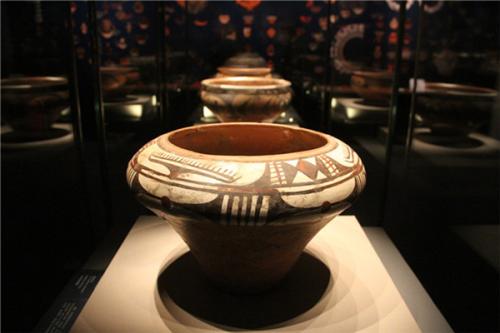
Painted Pottery Pot belongs to the Neolithic age, 45 cm in height, 35 cm in diameter, 43 cm in abdominal diameter, and 15.6 cm in the bottom. It was unearthed in Jinshengzhuang Village, Ruicheng County, Shanxi Province in 1989.
The pot was made of red pottery, with a polished surface. The shape of the jar is generally outward inclined along with the mouth, with rounded lips, short neck, wide shoulders, protruding upper abdomen, adduction of the lower abdomen, small flat bottom, black color painting on the upper abdomen, and arc and dot on the upper abdomen. It is huge and completely intact. It is a typical relic of Miaodigou Phase II in Yangshao culture.

Green Glazed Porcelain Teacups with Saucers were produced in the Northern Wei Dynasty (386-534). It is 6.7 cm in height, 9.1 cm in teacups diameter, 3.3 cm in foot diameter, and 15.3 cm in supporting parts (There is a raised support ring in the middle as support) diameter. It was unearthed in Dongtaibao Village, Taiyuan City, Shanxi Province in 1957.
The opening of the teacups converges slightly with a circular wall(The ceramic bottom is like the supporting part of the leg, and the shape is a round cake). The supporting part at the bottom is turned outward and the bottom is slightly concave. There is a supporting opening in the center of the tray. The body of porcelain is ochre gray, and the composition of the part under the paint surface is good. It is covered with green glaze, with dense pieces of different sizes.
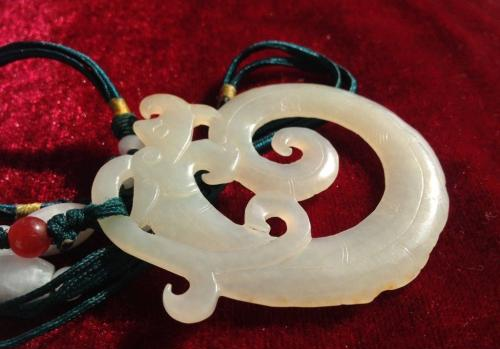
Jade Curled-up Dragon was produced in the Western Zhou Dynasty (1046 BC to 771 BC), with a diameter of 15.6 cm and an aperture of 6.8 cm. It was unearthed from Tomb No. 63 of Jin Hou Cemetery in Beizhao Village, Quwo County, Shanxi Province in 1993. The two sides of Jade curled-up dragon are the same, with two coil dragon patterns. The two dragons chase each other’s head and tail between the vortex line and the cirrus. And the space between the two dragons is carved with cirrus.
The decoration is carved with the double hook technique (Drawing the outline of an object with a line hook is generally called “hook”, and it is also called “double hook” because it is basically closed with left and right or up and down hooks). The owner of the tomb is Jin Muhou’s second wife.
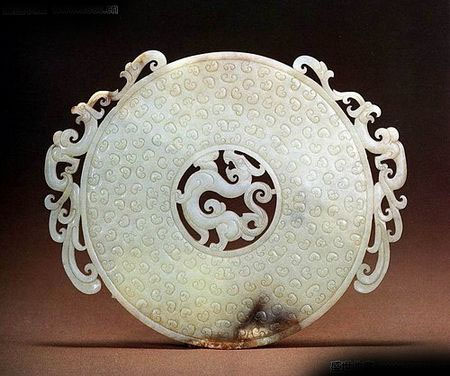
Dragon and Phoenix Jade Gui-shaped Decoration was produced in the Western Zhou Dynasty, which is 10.3 cm long and 3.8 cm wide. It was unearthed in Tomb 31 of Jin Hou Cemetery in Beizhao Village, Quwo County in 1992. The object is placed in the belly of the owner of the tomb, and it is brown. Its two sides are engraved with phoenix and dragon patterns of the same shape.
The phoenix has a crown, curved beak, round eyes, spreading wings, its tail feathers curl up to the beak, and the phoenix claws are placed on the dragon body. The dragon body is coiled, with a curled nose and embedded with turquoise.
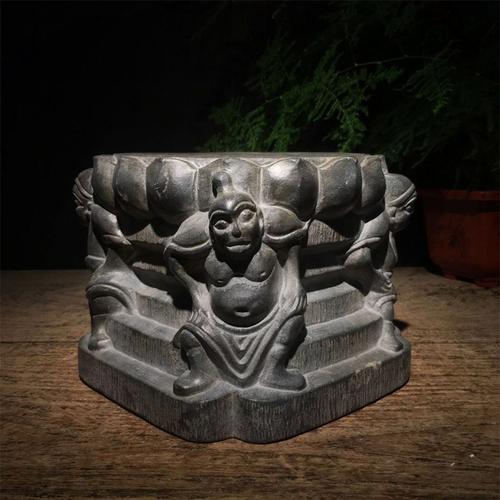
Stone Carving Plinth comes from the Northern Wei Dynasty, with a height of 16.5 cm, a base side length of 32 cm, and a column hole diameter of 7 cm. It was unearthed in 1965 from the tomb of Sima Jinlong, a high-ranking official in the Northern Wei Dynasty, who died in the eighth year of Taihe (484), in Shijiazhai Village, Datong City, Shanxi Province.
The foundation stone of one of the supporting pillars is light gray fine sandstone, with a square base, which is basin shaped. It has high relief lotus petals on the top and a circular Jack in the center. The surrounding carved dragon runs through the mountains.
The four sides of the square base are respectively carved with honeysuckle and cloud patterns, and the four corners of the base are respectively provided with a virtuoso boy who plays drums, blows bili (a wind instrument in ancient times), plays pipa, and dances.
On the four sides of the base of the column, there are shallow relief sculptures of entwined lotus branches, among which are the figures of acrobatics and music. A total of four pieces are slightly different in size and decoration.
It was produced in the Northern Wei Dynasty. It is 240 cm high, 348 cm long, and 338 cm wide. It was unearthed in the tomb of Song Shaozu, an official of the Northern Wei Dynasty who died in the first year (477) of Taihe in Caofulou Village, Datong City. It is composed of 109 pieces of finely carved bluestone components.
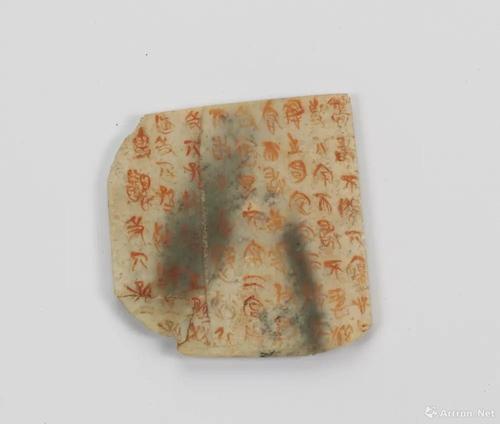
Houma Covenants were produced in the Spring and Autumn Period and were unearthed from the site of the Jin State in Houma City from 1965 to 1966. More than 5,000 pieces of jade and stone covenants were unearthed from more than 40 sacrificial pits. Most of them are Gui-shaped, with a length of 32 cm.
Most covenants were written with the red brush, and a few were with ink. There are 656 characters that can be identified. The content is mainly about the loyalty oath made by subordinates, the oath of allies, the marriage, curses, etc.
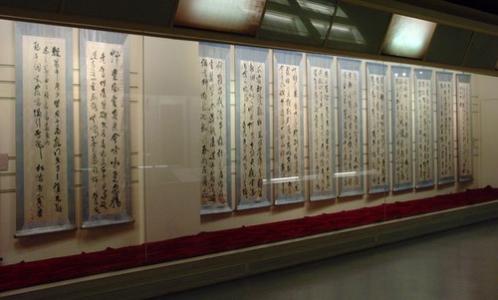
The Silk scroll Landscape Painting Presented to Fu Shan by Liang Tan is 79.5 cm in length and 32.8 cm in width.
Liang Tan, a native of Taiyuan, was born in the late Ming and early Qing Dynasty and died during the Kangxi Era. He is known as Tianwai Savage, Jianjia Master, and Shiya Hermit. He was not an official. His personality and art were highly valued by Fu Shan, a well-known calligrapher in Taiyuan.
Liang Tan was good at painting. He imitated ancient landscapes, figures, flowers and birds, insects, and fish. Fu Shan often asked him for his painting skills and gave them a biography. The calligraphy is elegant and has its own characteristics. This work was once appreciated by Fu Shan.
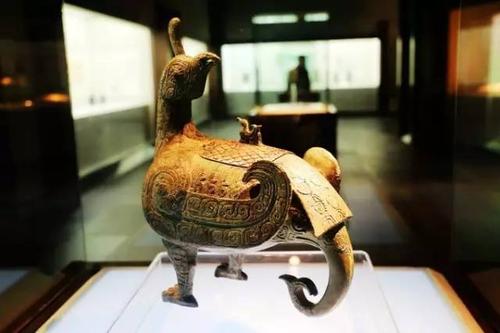
The original owner of the Bird-shaped Zun (wine vessel) is Xiefu (See the first story). The wine vessel is previously used in sacrifice. The whole Bird-shaped Zun takes the shape of a bird, which is looking back, as the main design. On the back of the bird sits a little bird. A lovely elephant nose pokes out its head at the tail of the bird, and its long nose forms a tripod with the phoenix’s feet, ensuring the stability of the bird statue.
Bird and elephant were the most popular decorative patterns at that time. Their perfect combination made Bird-shaped Zun a rare treasure in Chinese bronze art. Standing in front of this exquisite bird statue, we seem to feel a kind of vigorous vitality and the ambition of Xiefu.

It was about 3000 years ago in the Western Zhou Dynasty when 13-year-old King Cheng of Zhou (1055 BC - 1021 BC) and his little brother played games together. King Cheng picked up a phoenix tree leaf from the ground, and said to his brother, “With this leave, you will be a vassal!”
The historiographer recorded this sentence and asked King Cheng to fulfill his promise and said, “The King, as the son of heaven, does not make jokes”. So, King Cheng made his brother Shuyu a vassal in the State of Tang. Later, Shuyu’s son Xiefu succeeded to the throne and changed the title of the place from “Tang” to “Jin”, which gradually developed into a powerful country. People in Shanxi today are still proud of this glorious history and call the magic land “Jin” for short.
There are 16 complete sets of Jinhou Chimes. Now the 14 big chimes are kept in Shanghai Museum, and two small ones are stored in Shanxi Museum. Jinhou Chimes experienced a legendary story.
In August 1992, archaeological work in the cemetery of the eighth Jin Marquis (Jinhou) was interrupted due to the local autumn harvest. Therefore, the excavation of the tomb stopped. During this time, the crazy tomb robbers extended their black hands to the tomb and smuggled out 14 chimes stolen from the tomb.

In the winter of the same year, the tomb of the eighth Jin Marquis was cleared up. Archaeologists found two chimes that the tomb robbers had left out, which were first displayed in the display cabinet. They are the smallest two chimes in the whole set. Maybe it was because of the small size that they survived.
In December of the same year, Mr. Ma Chengyuan, the curator of Shanghai Museum and a famous Chinese bronze expert, found the remaining 14 chimes in Hong Kong. With the help of Professor Zhang Guangyu of the Chinese University of Hong Kong, he spent a large sum of money rescuing the chimes.
After the experts’ derusting treatment, the words miracle appeared. The 355 characters carved on this set of chimes completely recorded the story of the eighth Jin Marquis, who led his army to inspect the eastern land with the king in the 33rd year of King Li of Zhou, fought against the rebellious minority tribes, and was awarded by King Li for his meritorious deeds.
Today, this set of bell chimes are reunited in China. And they have been exhibited in Shanghai, Macao, and other places along with other high-quality cultural relics unearthed from the tombs of the Marquis of Jin. In 2002, the chimes were listed as one of the first Chinese cultural relics banned from being exhibited abroad.
Shanxi is known as “the cradle of Chinese opera art”, especially the southern part of Shanxi Province. Since ancient times, Shanxi has been prosperous in economy and culture. So, Shanxi became the fertile land for the growth of operas in the Song and Yuan Dynasties.
From the initial sacrificial activities to the palace banquet, traditional Chinese opera has gradually developed into a comprehensive performance art form that enlightens the public and reflects the social situation. Due to the influence of Neo Confucianism, filial son stories were very popular in the Song Dynasty.

Twenty-four typical stories with the theme of filial piety were compiled into a volume and widely spread among the people. A group of sculptures unearthed from Jin tombs in Jishan County, Shanxi Province, show that the stories of the twenty-four filial piety figures had been popular in Shanxi in ancient times. Among them, many stories, such as Min Sun and his stepmother, are still performed in Shanxi Jin Opera and Pu Opera. Here is the story:
Min Sun was born in Lu State in the Spring and Autumn Period and was a disciple of Confucius. His mother died early and his father remarried. Then they had two sons. His stepmother often abused him. In the winter days, his two brothers wore winter clothes made of cotton, but he was only given cotton-padded clothes made of reed catkins. One day, when his father went out, Min Sun shivered because of the cold weather when he was pulling the cart. He was so cold that he dropped the bridle to the ground and was scolded and whipped by his father. The reed flowers flew out from the broken seam of his clothes. At this time, his father came to know that Min had been abused.
The father returned home deciding to divorce his wife. Min Sun knelt and begged his father to forgive his stepmother, saying, “If you forgive my stepmother, I was the only one to suffer from the cold. But if you drive my stepmother away, all three children will suffer.” His father was very moved, so he did not divorce his wife. After hearing this, his stepmother was filled with remorse, and from then on, she treated Min Sun just like her own sons.
Many of the stories have been popular throughout China and many operas have been performed to educate young people to pay respect to the old people.
Enter from the East Gate→ Visit the temporary exhibition hall on the first floor→ Visit on the second floor→ The Achievements of Jin Kingdom→The Trace of the Xia and Shang Dynasties→The Cradle of Civilization→ Visit the third floor→ The Relics of Buddhism→ The Hometown of Operas→ Shanxi Merchants→The Melting Pot of Different Nationalities→Visit the fourth floor→ Ancient Architecture→Ancient Chinese Currency→Ancient Chinese Porcelain→Ancient Chinese Painting and Calligraphy→ Jade exhibition→ Exit from the East Gate
Take bus 308, 903, 618, K809, 863, and get off at Yingzeqiao West Station. After getting off, walk about 50 meters along the Wenxing Road, and then walk straight for about 560 meters, turn right, walk about 20 meters to the destination.
Take bus 6, 803, 602, and get off at Yifenqiao West Station. After getting off, walk about 170 meters along the Yifen street, turn right, walk 10 meters into the Wangjing Road, then walk straight for about 780 meters to the destination.
Chinese: 请带我去山西博物院。English: Please take me to Shanxi Museum.
If you go to Shanxi Museum from the Taiyuan city center (Shanxi Longcheng International Hotel), it takes about 20 minutes (about 15 yuan).
If you go to Shanxi Museum from Taiyuan Wusu International Airport, it takes about 40 minutes (about 50 yuan).
If you go to Shanxi Museum from Taiyuan Railway Station, it takes about 30 minutes (about 50 yuan).
If you go to Shanxi Museum from Taiyuan South Railway Station, it takes about 30 minutes (about 40 yuan).
